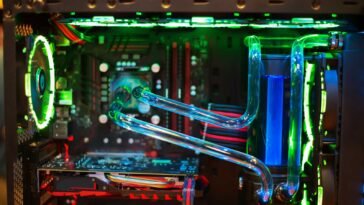Syncing performance plays a crucial role in the seamless operation of Windows 10 devices, impacting productivity, data accessibility, and overall user experience. In this article, we delve into essential tips and strategies to optimize syncing performance on Windows 10 systems. From evaluating current syncing issues to implementing network optimizations, updating software and drivers, and utilizing cloud storage services effectively, we will explore a comprehensive guide to enhance syncing efficiency and troubleshoot common problems. By understanding the significance of syncing performance and implementing the suggested best practices, users can ensure smooth data synchronization and maximize the potential of their Windows 10 devices.
Understanding the Importance of Syncing Performance on Windows 10
In a world where we’re constantly juggling multiple devices, ensuring smooth syncing performance on our Windows 10 devices is crucial. Whether it’s keeping our files up to date across devices or accessing the latest information on the go, syncing plays a vital role in our digital lives.
Exploring the Role of Syncing in Windows 10 Devices
Syncing in Windows 10 enables seamless integration between different devices, allowing for easy access to files, settings, and other data across platforms. It ensures that you can pick up where you left off, no matter which device you’re using, making multitasking a breeze.
Impact of Efficient Syncing on Productivity and Data Accessibility
Efficient syncing directly impacts productivity by saving you time and effort spent manually transferring or updating files. It enhances data accessibility by ensuring that the most current information is available across all your devices, empowering you to work efficiently and stay organized.
Evaluating Current Syncing Performance Issues
Despite the convenience syncing offers, performance issues can sometimes arise, slowing down the process. Identifying the factors affecting syncing speed and monitoring performance metrics can help address these issues effectively.
Identifying Common Factors Affecting Syncing Speed
Factors such as network connectivity, device settings, and software configurations can impact syncing speed. By pinpointing these common culprits, you can take targeted steps to improve syncing performance and enhance your overall user experience.
Tools and Methods for Assessing Syncing Performance Metrics
Utilizing tools and methods to assess syncing performance metrics can provide valuable insights into the efficiency of your syncing processes. By monitoring key indicators, you can identify areas for improvement and optimize your syncing setup for better performance.
Optimizing Network Settings for Improved Syncing Performance
Network settings play a significant role in determining syncing performance on Windows 10 devices. Configuring Wi-Fi and Ethernet settings properly, as well as utilizing Quality of Service (QoS) features, can help enhance syncing speed and reliability.
Configuring Wi-Fi and Ethernet Settings for Optimal Syncing
Optimizing Wi-Fi and Ethernet settings involves ensuring a stable connection, proper bandwidth allocation, and minimizing interference. By fine-tuning these settings, you can create an optimal network environment for efficient syncing on your Windows 10 devices.
Utilizing Quality of Service (QoS) Features for Prioritizing Syncing Traffic
Quality of Service (QoS) features allow you to prioritize syncing traffic over other network activities, ensuring that crucial data transfers occur smoothly and without delays. By leveraging QoS features, you can prioritize syncing tasks and improve overall performance.
Managing Syncing Frequency and Preferences
Customizing syncing frequency and preferences according to your needs can further optimize syncing performance on Windows 10 devices. Setting up scheduled syncing tasks and adjusting preferences based on your requirements can streamline the syncing process.
Setting Up Scheduled Syncing Tasks
Scheduled syncing tasks automate the process of keeping your files updated across devices at regular intervals. By setting up a syncing schedule that aligns with your workflow, you can ensure that your data is always current without manual intervention.
Customizing Syncing Preferences Based on Requirements
Tailoring syncing preferences to suit your specific requirements allows you to optimize the syncing process for efficiency and convenience. Whether it’s choosing which files to sync or adjusting sync settings for different networks, customizing preferences ensures a seamless syncing experience.**Tips for Winning the Syncing Game on Your Windows 10 Device**
**Utilizing Cloud Storage Services for Efficient Data Syncing**
**Integrating OneDrive or other Cloud Services for Seamless Syncing**
Syncing your data with the cloud can be a game-changer for efficiency. Whether you’re using OneDrive or other cloud services, integrating them into your workflow can make syncing a breeze.
**Optimizing Cloud Storage Settings for Faster Syncing Processes**
Don’t let your cloud storage just sit there – optimize its settings for speed! Adjusting parameters like sync frequency and bandwidth usage can significantly improve the syncing process.
**Updating Software and Drivers for Enhanced Syncing Performance**
**Ensuring Windows 10 and Syncing Software are Up to Date**
Just like a fine wine, software gets better with age – make sure your Windows 10 and syncing software are up to date. This ensures you’re getting the latest performance improvements and bug fixes.
**Updating Network Drivers for Improved Data Transfer Speeds**
Your network driver is like the unsung hero of syncing – keep it updated to maximize data transfer speeds. A simple driver update can sometimes be the boost your syncing needs.
**Implementing Security Measures to Safeguard Synced Data**
**Enabling Encryption for Securing Synced Files**
Keep your synced data safe from prying eyes by enabling encryption. It’s like giving your files a secret code that only you can unlock – a must-have for sensitive information.
**Configuring Firewall and Antivirus Settings to Protect Synced Data**
Think of your firewall and antivirus as the bodyguards of your synced data. Configuring them properly ensures that no harmful elements can sneak in and disrupt your syncing harmony.
**Monitoring and Troubleshooting Syncing Performance Issues**
**Utilizing Task Manager and Resource Monitor to Monitor Syncing Processes**
Keep an eye on your syncing processes like a hawk with Task Manager and Resource Monitor. They give you the power to identify any syncing bottlenecks and address them promptly.
**Troubleshooting Common Syncing Problems and Error Messages**
Syncing isn’t always smooth sailing – be prepared to troubleshoot common problems and error messages. With a bit of know-how and patience, you can conquer any syncing hiccups that come your way.
Now go forth, armed with these tips, and conquer the syncing world on your Windows 10 device! 🚀
Closing Thoughts
Efficient syncing performance is fundamental to maintaining a streamlined and productive computing experience on Windows 10 devices. By implementing the tips and strategies outlined in this article, users can optimize their syncing processes, enhance data accessibility, and minimize syncing-related issues. With a proactive approach to managing network settings, software updates, and security measures, users can ensure that their synced data remains secure and readily available whenever needed. By incorporating these practices into their syncing routines, Windows 10 users can experience a more seamless and efficient digital workflow.
Frequently Asked Questions
1. Why is syncing performance important on Windows 10 devices?
Syncing performance is crucial on Windows 10 devices as it ensures that data across multiple devices remains up to date and accessible. Efficient syncing improves productivity by allowing users to seamlessly access their files, documents, and settings across various platforms.
2. How can I troubleshoot syncing issues on my Windows 10 device?
To troubleshoot syncing issues on Windows 10, users can start by checking network connectivity, updating software and drivers, and monitoring syncing processes using built-in tools like Task Manager. Additionally, adjusting syncing settings and configurations can help resolve common syncing problems.
3. What security measures should I implement to protect synced data on Windows 10?
To safeguard synced data on Windows 10, users should enable encryption for sensitive files, configure firewall and antivirus settings, and regularly update security software. It is also advisable to use secure cloud storage services and enable two-factor authentication for added protection.
4. How often should I update software and drivers to maintain optimal syncing performance?
Regularly updating software and drivers is essential to ensure optimal syncing performance on Windows 10 devices. Users should check for updates periodically and install them promptly to benefit from improved functionality, bug fixes, and enhanced compatibility with syncing applications.






 No products in the cart.
No products in the cart.